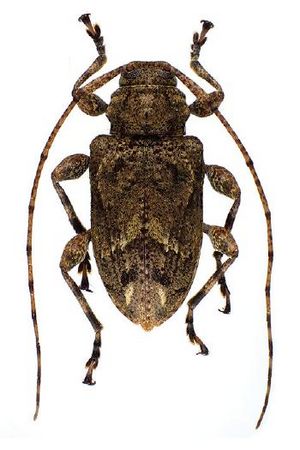Leptostylopsis milleri facts for kids
Quick facts for kids Leptostylopsis milleri |
|
|---|---|
 |
|
| Scientific classification | |
| Kingdom: | |
| Phylum: | |
| Class: | |
| Order: | |
| Family: | |
| Subfamily: |
Lamiinae
|
| Genus: |
Leptostylopsis
|
| Species: |
L. milleri
|
| Binomial name | |
| Leptostylopsis milleri Fisher, 1932
|
|
Leptostylopsis milleri is a fascinating type of longhorn beetle. These beetles are part of a large group called Lamiinae, which is a subfamily within the bigger Cerambycidae family. This particular species was first officially described by a scientist named Fisher in 1932.
Longhorn beetles are known for their very long antennae, which can sometimes be even longer than their bodies! They are found all over the world and come in many different shapes, sizes, and colors.
Contents
What are Longhorn Beetles?
Longhorn beetles are a big family of insects. They are called "longhorn" because of their antennae. These antennae are usually very long and often curve backward over their bodies. Beetles use their antennae to feel, smell, and sometimes even hear things around them.
There are thousands of different kinds of longhorn beetles. They live in many different places, from forests to deserts. Many of them play an important role in nature by helping to break down dead wood.
Amazing Antennae
The antennae of longhorn beetles are truly amazing. They are made up of many small segments. These segments can move independently, allowing the beetle to explore its surroundings. The antennae are covered with tiny sensors. These sensors help the beetle find food, mates, and safe places to live.
Some longhorn beetles have antennae that are twice as long as their bodies. This makes them look quite unique! The length and shape of the antennae can also help scientists identify different species.
Life Cycle of a Beetle
Like all insects, Leptostylopsis milleri goes through a complete metamorphosis. This means it changes a lot during its life. It starts as an egg, then becomes a larva, then a pupa, and finally an adult beetle.
Egg Stage
The life of a longhorn beetle begins as a tiny egg. Female beetles usually lay their eggs in cracks or crevices of wood. They choose wood that is either dead or dying. This wood will become the first meal for their babies.
The eggs are often very small and hard to see. They are carefully placed to protect the developing beetle inside.
Larva Stage
Once the egg hatches, a larva emerges. This larva is often called a "grub." Longhorn beetle larvae are usually pale, worm-like creatures. They have strong jaws for chewing wood. These larvae spend most of their lives inside wood.
They tunnel through the wood, eating as they go. This stage can last for several months or even years. The larvae grow bigger with each meal. They shed their skin several times as they grow.
Pupa Stage
After the larva has grown enough, it changes into a pupa. The pupa stage is a resting stage. During this time, the beetle transforms from a grub into its adult form. The pupa does not eat or move much.
It usually stays hidden inside the wood. Inside the pupal case, the beetle's body parts, like wings and long antennae, begin to form. This stage can last from a few weeks to several months.
Adult Stage
Finally, the adult beetle emerges from the pupa. It chews its way out of the wood. Adult longhorn beetles have hard outer wings that protect their delicate flying wings. They also have their characteristic long antennae.
Adult beetles focus on finding a mate and reproducing. They may also feed on sap, pollen, or sometimes even the bark of trees. Their lifespan as an adult is usually much shorter than their larval stage.
Where Do They Live?
Leptostylopsis milleri and other longhorn beetles are found in many different habitats. They often live in forests, woodlands, and areas with plenty of trees. This is because their larvae depend on wood for food and shelter.
Some species prefer specific types of trees. Others can live in various kinds of wood. They are an important part of the forest ecosystem.
What Do They Eat?
As larvae, longhorn beetles like Leptostylopsis milleri are mostly wood-eaters. They tunnel through the wood, digesting the plant material. This helps to recycle nutrients back into the environment.
Adult longhorn beetles have different diets. Some adults do not eat at all. Others feed on tree sap, pollen, or nectar from flowers. A few species might nibble on leaves or bark.
Discovering New Species
The scientist who described Leptostylopsis milleri was named Fisher. When a scientist "describes" a new species, it means they are the first to formally name it and write down its unique features. This helps other scientists identify and study the creature.
Naming new species is an important part of biology. It helps us understand the amazing variety of life on Earth. Each new discovery adds to our knowledge of the natural world.

